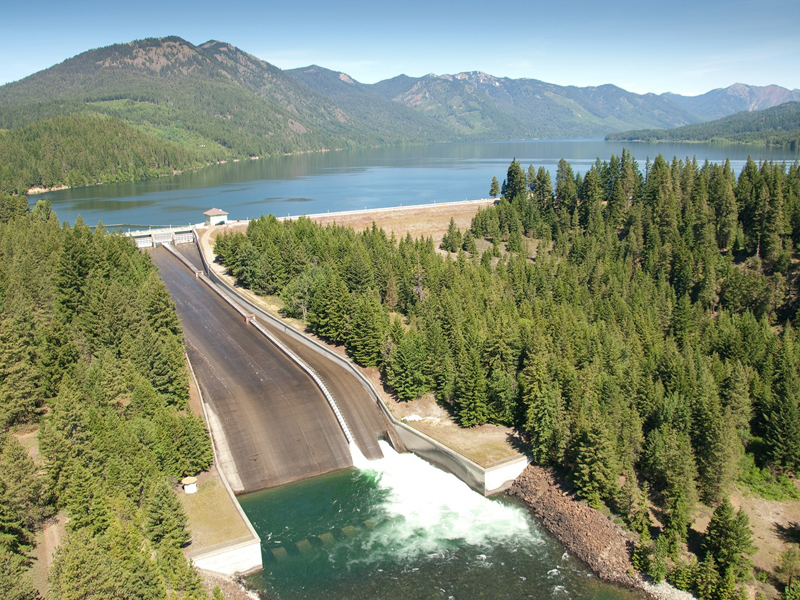After a warm winter, the Yakima Basin is heading into an irrigation season with a projected 72 percent of its normal water supply. While no water users are being curtailed at this time, that could likely happen in the following months. Ecology will notify those users when that occurs.
The main takeaway: we are early in the season, and conditions can change. We’re taking steps to respond to reduced water supply and minimize the impacts on people, fish, and farms. Make plans to stay mindful of your water usage in the coming months.
Current drought conditions
Lake Kachess in 2012 (top) and during the 2015 drought (bottom).
We are currently in a drought. Last July, the state declared a drought emergency in the Yakima River Basin. That declaration remains in effect until June 30 this year and will likely be extended through the irrigation season.
As conditions evolve this spring, we may expand the drought declaration to other parts of the state, which makes state emergency drought funds available to those areas.
With water levels expected to drop below minimum instream flows, we plan to issue curtailment notices to junior water right holders in the Yakima Basin. Curtailments help prevent further decline in rivers with instream flow rules, and they protect senior water right holders from having their water use impaired by junior water right holders.
While we monitor the situation, we are doing everything we can to reduce hardship on the basin.
Emergency drought well program
To help with reduced water supply, we’ll begin accepting applications to pump emergency drought wells.
Under this program, when the Yakima Basin’s water supply is forecasted below 75 percent, water users in pro-ratable irrigation districts can apply for one-year authorizations to pump from emergency drought wells, supplementing their diminished water deliveries.
If you’re eligible and plan to apply for the program, you’ll need to provide mitigation to offset the amount you plan to pump. We’re offering limited financial assistance to help with this, so apply early.
Here’s what that financial assistance looks like.
- Though a partnership with the Selah-Moxee Irrigation District (SMID) water bank, we’re offering a 25 percent match for up to 75 percent of your normal water supply.
- Mitigation from the SMID water bank is $300 per acre-foot. Under the cost share terms, you’d pay $225 per acre-foot and we’d pay $75.
- The total volume available for cost share is limited, so get your application in early if you’d like to take advantage of this opportunity.
You can purchase additional mitigation up to 100% of your normal water supply with SMID or with a different water bank, though you’ll have to cover that expense on your own.
If you apply, we’ll also check to make sure there’s enough groundwater available in your location, and that you can legally use it. Your application may be denied if your well is drilled into a declining aquifer, or if pumping from your well will impact nearby water users.
To apply or learn more, contact Kelsey Collins:
Kelsey.Collins@ecy.wa.gov
509-931-0976
Tracking water usage
A telemetered meter installed on an outdoor pipe
Even outside of a drought, water is a finite resource in the Yakima Basin. We need to responsibly manage what we use so communities and ecosystems have enough. All drought wells must submit metering data to track how much groundwater is being pumped.
If you apply to drill a new or replacement well this year, you’re required to install a telemetered meter. These devices track how much water is pumped and automatically send the readings to an online platform we can access.
Proper metering helps water users stick to what they’ve been authorized to pump so we don’t overuse the basin’s water supplies. This is an important part of minimizing the hardships of drought on our communities.
Telemetered meters also give us data to assess how much longer water will be available in declining aquifers, shaping how we plan to support those areas in the long term.
Installing these meters can be expensive. We’ll soon introduce a new program to help with that cost, and we encourage all drought well users to take advantage of it. While telemetered meters are only required on new wells this year, they’ll be required for all emergency drought wells in the coming years. Funding through that program is first come, first served.
Preparing for a drier future
Cle Elum Dam, the site of an important fish passage project. Photo from U.S. Bureau of Reclamation.
We’re focused on investing in climate resiliency for local communities and enhancing water security for generations to come. As climate change pushes temperatures higher and reduces snowpack, we’re seeing drops in river flows and water supplies. Because of that, we’re collaborating with local and state partners to prepare our region to withstand these challenges. Our projects include conservation efforts, surface water storage, and enhancing fish passage.
In addition, we’re piloting a new drought planning and preparedness grant program. These competitive grants will support local governments as they create drought preparedness plans. The application period closed earlier this month, and we anticipate issuing funds this summer.
We’re also working with the U.S. Geological Survey to model estimated groundwater availability in the lower Yakima Basin. This information will guide our planning efforts, including future authorizations for emergency drought wells.
What you can do
The monthly water outlook for the Yakima Basin will next be updated on April 4. It may be influenced by quick changes in spring weather conditions.
We encourage you to conserve water as much as you can, even though we’re hoping for a cool, wet spring to boost our water supply. Until we know more, we are keeping a close eye on water supplies and are prepared to act to support the Yakima Basin.



